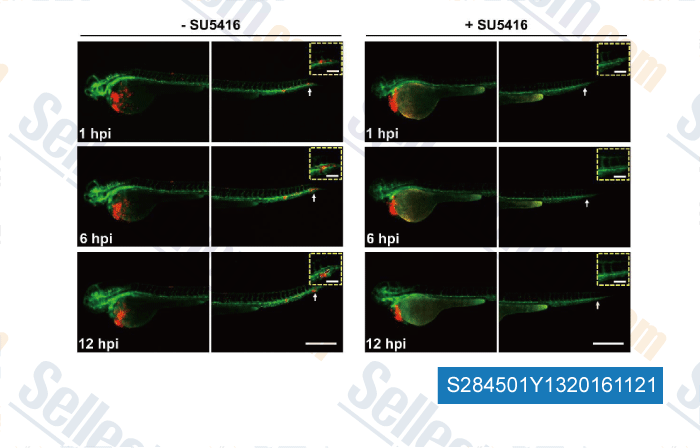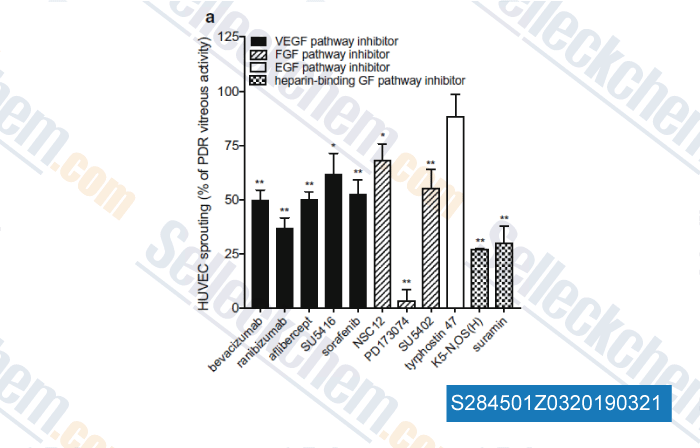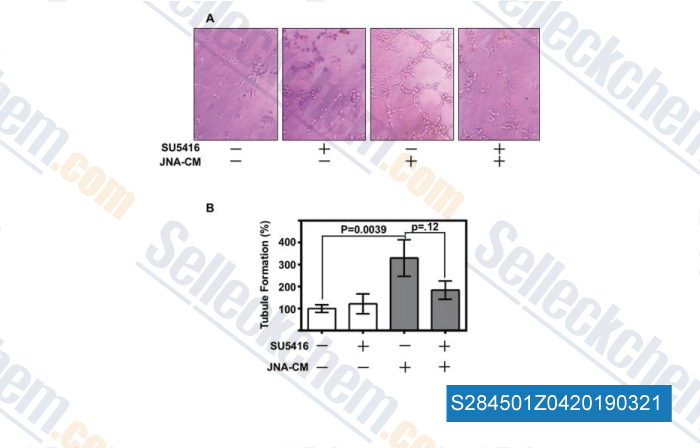|
Toll Free: (877) 796-6397 -- USA and Canada only -- |
Fax: +1-832-582-8590 Orders: +1-832-582-8158 |
Tech Support: +1-832-582-8158 Ext:3 Please provide your Order Number in the email. |
Technical Data
| Formula | C15H14N2O |
||||||||||
| Molecular Weight | 238.28 | CAS No. | 204005-46-9 | ||||||||
| Solubility (25°C)* | In vitro | DMSO | 16 mg/mL (67.14 mM) | ||||||||
| Ethanol | 3 mg/mL (12.59 mM) | ||||||||||
| Water | Insoluble | ||||||||||
| In vivo (Add solvents to the product individually and in order) |
|
||||||||||
|
* <1 mg/ml means slightly soluble or insoluble. * Please note that Selleck tests the solubility of all compounds in-house, and the actual solubility may differ slightly from published values. This is normal and is due to slight batch-to-batch variations. * Room temperature shipping (Stability testing shows this product can be shipped without any cooling measures.) |
|||||||||||
Preparing Stock Solutions
Biological Activity
| Description | Semaxanib (SU5416, semaxinib) is a potent and selective VEGFR(Flk-1/KDR) inhibitor with IC50 of 1.23 μM, 20-fold more selective for VEGFR than PDGFRβ, lack of activity against EGFR, InsR and FGFR. Phase 3.Semaxanib (SU5416) can be used to induce animal models of chronic intermittent hypoxia. | ||
|---|---|---|---|
| Targets |
|
||
| In vitro | Semaxanib inhibits VEGF-dependent phosphorylation of the Flk-1 receptor in Flk-1-overexpressing NIH 3T3 cells with IC50 of 1.04 μM. Semaxanib inhibits PDGF-dependent autophosphorylation in NIH 3T3 cells with IC50 of 20.3 μM. Semaxanib inhibits VEGF- and FGF-driven mitogenesis in a dose-dependent manner with IC50 of 0.04 and 50 μM, respectively. Semaxanib treatment has no effect on the in vitro growth of C6 glioma, Calu 6 lung carcinoma, A375 melanoma, A431 epidermoid carcinoma, and SF767T glioma cells (all IC50s > 20 μM). [1] | ||
| In vivo | Semaxanib dose-related inhibits growth of A375 tumor in vivo. A >85% inhibition of subcutaneous tumor growth is observed with daily i.p. administration of SU5416 in DMSO at Semaxanib, without measurable toxicity. Semaxanib shows broad spectrum antitumor activity. SU5416 significantly inhibits the subcutaneous growth of 8 of 10 tumor lines tested (A431, Calu-6, C6, LNCAP, EPH4-VEGF, 3T3HER2, 488G2M2 and SF763T cells) with an average mortality rate of 2.5%. [1] Semaxanib (25 mg/kg/day) displays potent antiangiogenic activity, resulting in a significant reduction of both the total and functional vascular density of the tumor microvasculature. [2] |
Protocol (from reference)
| Kinase Assay:[1] |
|
|---|---|
| Cell Assay:[1] |
|
| Animal Study:[1] |
|
References
|
Customer Product Validation

-
Data from [Data independently produced by , , Sci Rep, 2016, 6:19304. ]

-
Data from [Data independently produced by , , Angiogenesis, 2017, 20(4):629-640]

-
Data from [Data independently produced by , , Int Forum Allergy Rhinol, 2017, 7(10):973-979]
Selleck's Semaxanib (SU5416) has been cited by 22 publications
| Gliovascular transcriptional perturbations in Alzheimer's disease reveal molecular mechanisms of blood brain barrier dysfunction [ Nat Commun, 2024, 15(1):4758] | PubMed: 38902234 |
| Gliovascular transcriptional perturbations in Alzheimer's disease reveal molecular mechanisms of blood brain barrier dysfunction [ Nat Commun, 2024, 15(1):4758] | PubMed: 38902234 |
| Gliovascular transcriptional perturbations in Alzheimer's disease reveal molecular mechanisms of blood brain barrier dysfunction [ Nat Commun, 2024, 15(1):4758] | PubMed: 38902234 |
| Endothelial Slc35a1 Deficiency Causes Loss of LSEC Identity and Exacerbates Neonatal Lipid Deposition in the Liver in Mice [ Cell Mol Gastroenterol Hepatol, 2024, 17(6):1039-1061] | PubMed: 38467191 |
| Endothelial Slc35a1 Deficiency Causes Loss of LSEC Identity and Exacerbates Neonatal Lipid Deposition in the Liver in Mice [ Cell Mol Gastroenterol Hepatol, 2024, 17(6):1039-1061] | PubMed: 38467191 |
| A novel twelve-gene signature to predict neoadjuvant chemotherapy response and prognosis in breast cancer [ Front Immunol, 2022, 13:1035667] | PubMed: 36341435 |
| VEGF Modulates Neurogenesis and Microvascular Remodeling in Epileptogenesis After Status Epilepticus in Immature Rats [ Front Neurol, 2021, 12:808568] | PubMed: 35002944 |
| PKR deficiency alleviates pulmonary hypertension via inducing inflammasome adaptor ASC inactivation [ Pulm Circ, 2021, 11(4):20458940211046156] | PubMed: 34540200 |
| Uncovering mutation-specific morphogenic phenotypes and paracrine-mediated vessel dysfunction in a biomimetic vascularized mammary duct platform [ Nat Commun, 2020, 11(1):3377] | PubMed: 32632100 |
| RhoJ integrates attractive and repulsive cues in directional migration of endothelial cells [ EMBO J, 2020, 39(12):e102930] | PubMed: 32347571 |
RETURN POLICY
Selleck Chemical’s Unconditional Return Policy ensures a smooth online shopping experience for our customers. If you are in any way unsatisfied with your purchase, you may return any item(s) within 7 days of receiving it. In the event of product quality issues, either protocol related or product related problems, you may return any item(s) within 365 days from the original purchase date. Please follow the instructions below when returning products.
SHIPPING AND STORAGE
Selleck products are transported at room temperature. If you receive the product at room temperature, please rest assured, the Selleck Quality Inspection Department has conducted experiments to verify that the normal temperature placement of one month will not affect the biological activity of powder products. After collecting, please store the product according to the requirements described in the datasheet. Most Selleck products are stable under the recommended conditions.
NOT FOR HUMAN, VETERINARY DIAGNOSTIC OR THERAPEUTIC USE.
